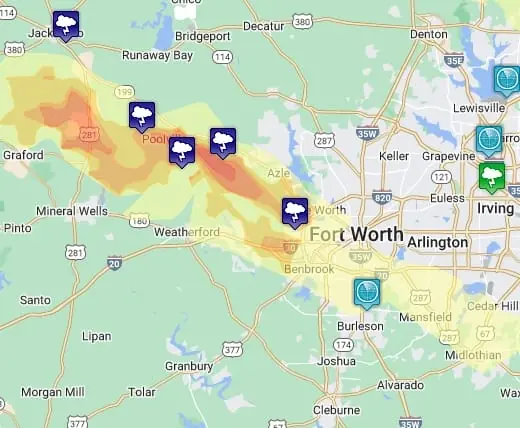1. Schedule a Preseason Inspection
Before hail season arrives, take the time to thoroughly document the condition of your home’s roof, exterior, and interior.
Why is this important?
Imagine getting into a car accident and having no pictures of your vehicle beforehand. The insurance company might argue that some of the dents and scratches were already there. The same thing can happen with your roof. Without proof of its condition before a storm, your insurance provider might claim the damage was “pre-existing” and deny your claim.
To prevent this:
✔ Take date-stamped photos & videos – Capture your roof, siding, and any other exterior features from multiple angles. If damage occurs later, you’ll have proof that it wasn’t there before.
✔ Inspect roofing, siding & gutters – Small cracks, loose shingles, or worn-out gutters can turn into major problems after a storm.
✔ Check your attic for leaks or water stains – Even small water spots could be a sign of a weakness that hail might exploit.
A professional inspection from a trusted local contractor, like Good Contractors Roofing and Restoration, can give you peace of mind and help establish the condition of your roof before storm season. Schedule your free inspection today.
2. Review Your Insurance Policy
Not all homeowners’ insurance policies provide the same level of coverage for hail damage. If you don’t understand your policy now, you could be in for a frustrating surprise when you file a claim. Think of your policy as a safety net—you don’t want to discover holes in it when you need it most!
Here are key factors to review:
Replacement Cost Value (RCV) vs. Actual Cash Value (ACV)
✅ Replacement Cost Value (RCV) Coverage: This is like having full coverage car insurance—your provider will pay for a full repair or replacement, minus your deductible.
❌ Actual Cash Value (ACV) Coverage: This is more like having liability-only car insurance. The insurer only pays for what your roof is worth at the time of damage, factoring in depreciation. If your roof is older, you might get far less than what’s needed for full repairs, leaving you with a hefty out-of-pocket cost.
Age-Based Roof Coverage
If your roof is 15 years or older, many policies only offer partial coverage, meaning you may have to cover more of the cost yourself. Insurance companies assume older roofs are already “worn out,” so they reduce the amount they’ll pay.
Roof Surface Payment Schedule
Some insurance companies reduce how much they’ll pay for a roof replacement over time, almost like a decreasing warranty. Here’s an example:
- Year 1: Insurance covers 100% of the replacement cost (minus your deductible).
- Year 2: Insurance covers 96% of the replacement cost.
- Year 3: Insurance covers 92%, and so on.
This means the longer you wait to replace your roof after damage, the more you may have to pay out-of-pocket.
Exclusions to Watch For
Many policies have hidden exclusions that homeowners don’t realize until it’s too late.
🚨 Cosmetic Exclusions: If hail dents your roof but doesn’t cause leaks, your insurer might not cover repairs—even if it ruins the look of your home.
🚨 Metal Exclusions: Some policies don’t cover damage to vents, gutters, or chimney caps—leaving you to replace them yourself.
Deductible Amounts
Many homeowners assume they have a 1% deductible, but some policies include a 2% deductible for wind and hail damage.
What does this mean for you?
- If you own a $300,000 home, a 1% deductible means you pay $3,000 before insurance kicks in.
- A 2% deductible means you’ll owe $6,000 out of pocket before your insurance covers anything.
✅ The best way to avoid surprises? Review your policy annually with your insurance agent to ensure you have adequate protection.
3. Have a Reliable Restoration Contractor on Speed Dial
After a major hailstorm, it’s common to see out-of-town “storm chasers” knocking on doors, offering quick fixes. Unfortunately, many of these contractors cut corners or disappear after completing subpar work, leaving homeowners with more problems than before.
🔹 Think of it like hiring a mechanic: You wouldn’t trust a random person who shows up at your door to fix your car, so why trust just anyone with your home?
To avoid scams and ensure high-quality repairs, it’s best to establish a relationship with a trusted local contractor before storm season arrives.
Why Choose Good Contractors Roofing and Restoration?
✔️ Professional roof inspections, repairs, and full roof replacements
✔️ Storm damage restoration, including hail and wind damage repair
✔️ Fire and water damage restoration
✔️ Guidance through the insurance claims process to help you get the coverage you deserve
Having a reliable restoration contractor in your contacts can make all the difference when a storm hits. Whether you need a quick roof repair or a full roof replacement, our team is ready to help restore your home with quality workmanship and exceptional service.
Don’t Wait Until It’s Too Late!
Hail season can be unpredictable, but your preparedness doesn’t have to be. By taking proactive steps now, you can protect your home, simplify the insurance claims process, and ensure you’re covered when you need it most.
If you need a preseason roof inspection or expert guidance on storm preparation, contact Good Contractors Roofing and Restoration today! We’re here to help.
📍 Serving Fort Worth, Arlington, Burleson, Weatherford, and surrounding areas
📞 (682) 842-7663

